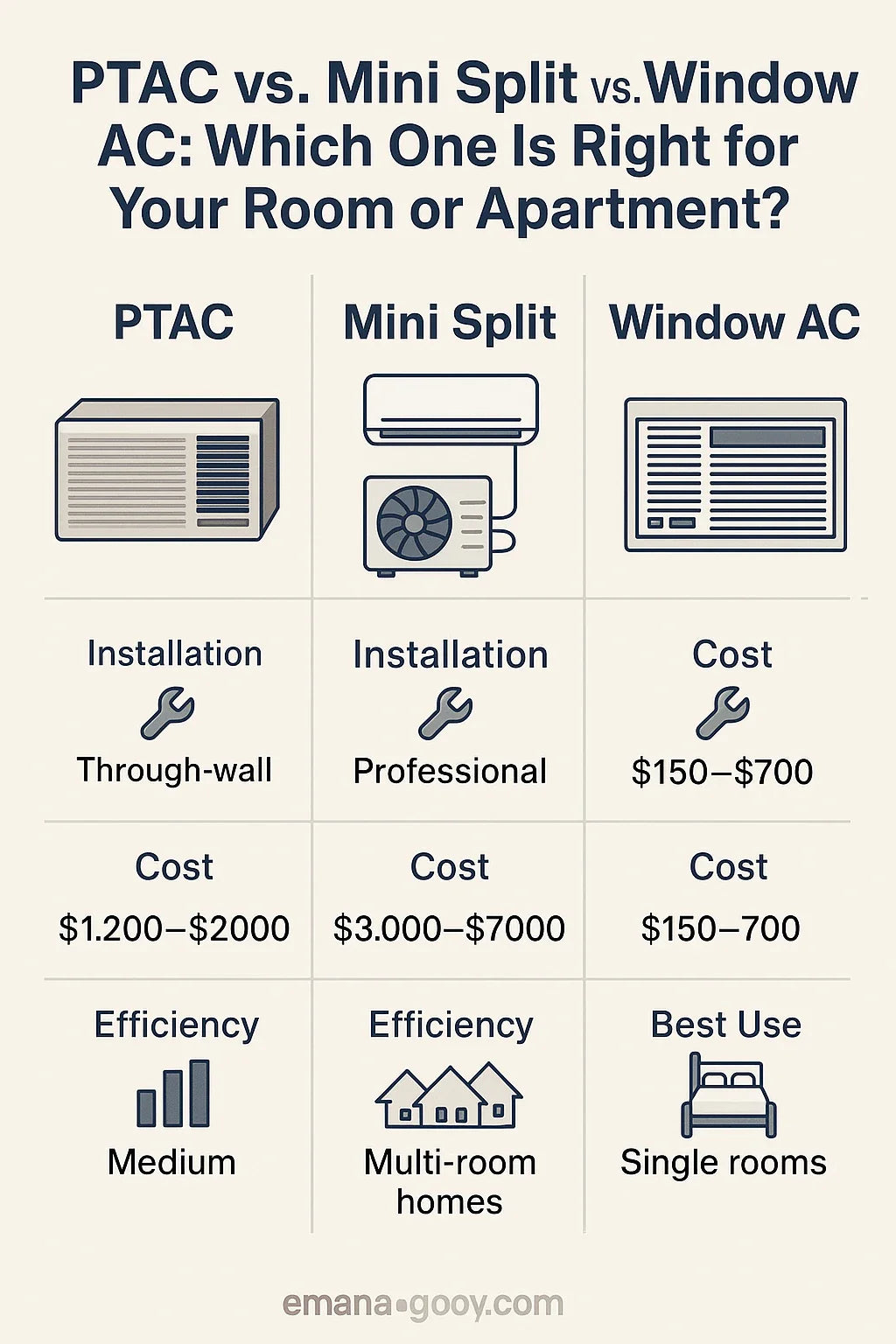👋 Introduction: Mike’s Cooling Dilemma
When Mike moved into his 550 sq. ft. apartment in Cleveland, he faced the same tough choice many homeowners, landlords, and renters face:
👉 “Do I go with a PTAC unit, a mini split, or just stick with a window AC?”
Each system promised cooling power, but the differences in cost, efficiency, and comfort made the decision more complex than just picking a brand. Mike wanted year-round comfort without wasting money—and he wanted a system he could count on for the long haul.
Amana Distinctions Model 12,000 BTU PTAC Unit with Heat Pump and 5 kW Electric Heat Backup
This guide breaks down the pros, cons, and real-world costs of PTACs, mini splits, and window ACs so you can make the best decision for your space—just like Mike did.
❄️ What Is a PTAC Unit?
A Packaged Terminal Air Conditioner (PTAC) is a self-contained unit that provides both cooling and heating. You’ve probably seen them in hotels, assisted living facilities, and apartments.
✅ PTAC Strengths:
-
All-in-one system: Cooling + heat pump + electric heat backup.
-
Permanent installation: Fits through-the-wall with a wall sleeve.
-
Good for medium-sized rooms: Typically 300–600 sq. ft.
-
Reliable heating backup: Electric strip heaters ensure comfort in winter.
⚠️ PTAC Limitations:
-
Requires a sleeve and grill ($150–$200).
-
Professional installation may be needed.
-
Can be noisier than mini splits.
-
Not portable—permanent solution.
👉 Mike’s take: For his apartment, the Amana 12,000 BTU PTAC with heat pump and 5kW backup offered the best of both worlds—cooling in the summer and heating in the winter.
📎 Reference: Amana PTAC Units
🌬️ What Is a Mini Split System?
A mini split (ductless heat pump or AC) is made up of an outdoor condenser and one or more indoor air handlers. They’re known for high efficiency and zoning flexibility.
✅ Mini Split Strengths:
-
Extremely efficient (SEER2 ratings often 20+).
-
Zoning control: Different temps for different rooms.
-
Quiet operation: Indoor units are nearly silent.
-
Rebate eligible: Often qualifies for tax credits and incentives.
⚠️ Mini Split Limitations:
-
High upfront cost: $3,000–$7,000 installed.
-
Requires a professional installation.
-
Wall-mounted units may not fit every décor.
👉 Mike’s take: While tempted by the efficiency, the price tag made this option less attractive for his single apartment.
📎 Reference: Energy.gov – Ductless Mini Splits
🪟 What Is a Window AC?
Window air conditioners are the most familiar cooling option for many renters and small homeowners. They’re compact, easy to install, and affordable.
✅ Window AC Strengths:
-
Lowest upfront cost: $250–$700.
-
Easy DIY install: Slide into a window and plug in.
-
Perfect for small rooms (<400 sq. ft.).
⚠️ Window AC Limitations:
-
Cooling only: Most don’t provide heat.
-
Blocks natural light and window access.
-
Less efficient than PTACs and mini splits.
-
Noisy operation.
👉 Mike’s take: If he only needed cooling for his bedroom, a window AC might’ve worked. But needing heat in the winter ruled this out.
📎 Reference: Energy Star – Room Air Conditioners
📊 Side-by-Side Comparison
Here’s the chart Mike built before making his choice:
| Feature | PTAC | Mini Split | Window AC |
|---|---|---|---|
| Installation | Through-wall, sleeve needed | Professional install, indoor + outdoor units | DIY, slides into window |
| Cost (Installed) | $1,200–$2,000 | $3,000–$7,000 | $250–$700 |
| Heating | Yes (heat pump + electric backup) | Yes (heat pump) | No (cooling only, unless hybrid) |
| Efficiency | Medium (EER 9–12) | High (SEER2 18–22+) | Low (EER 8–10) |
| Noise | Moderate | Very quiet | Loud |
| Best Fit | Apartments, hotels, year-round use | Multi-room homes, high efficiency seekers | Small rooms, renters, short-term cooling |
💵 Cost Breakdown
Mike compared total costs, including equipment + accessories + installation:
-
PTAC:
-
Unit: $950–$1,100
-
Sleeve & grill: $150–$200
-
Install: $300–$600
-
Total: $1,400–$2,000
-
-
Mini Split:
-
Unit: $2,500–$5,000
-
Install: $1,500–$2,500
-
Total: $3,000–$7,000
-
-
Window AC:
-
Unit: $250–$700
-
Install: DIY
-
Total: $250–$700
-
⚡ Efficiency & Rebates
-
Mini Splits: Often qualify for Inflation Reduction Act rebates and local utility credits.
-
PTAC Units: If heat pump-equipped, some utilities offer rebates.
-
Window ACs: Few rebates, unless Energy Star certified.
📎 Check programs here:
✅ Pros & Cons at a Glance
PTAC Units
✔ All-in-one heating & cooling
✔ Reliable electric backup heat
✔ Affordable compared to mini splits
✘ Requires wall cutout/sleeve
✘ Noisier than mini splits
Mini Splits
✔ Highest efficiency & quietest
✔ Zoned comfort for multiple rooms
✔ Qualifies for rebates
✘ Expensive upfront
✘ Requires pro install
Window ACs
✔ Cheapest option
✔ Quick DIY install
✔ Great for temporary cooling
✘ Cooling-only (usually)
✘ Noisy and blocks window
👨 Mike’s Recommendation by Situation
-
Small rental / temporary housing → Window AC
-
Studio apartment / guest suite / single room → PTAC
-
Multi-room home / long-term investment → Mini Split
👉 Mike went with the 12,000 BTU Amana PTAC for his apartment. It gave him cool summers, warm winters, and peace of mind—without breaking the bank.
🧾 Conclusion: Which One Is Right for You?
The choice between PTAC vs. mini split vs. window AC comes down to:
-
Budget (window ACs are cheapest, mini splits are premium).
-
Space size (window AC <400 sq. ft., PTAC 400–600 sq. ft., mini split multi-zone).
-
Heating needs (PTACs and mini splits provide heating, window ACs usually don’t).
For Mike’s situation, the PTAC was the perfect balance of year-round comfort, reasonable cost, and reliable backup heating.
If you’re in a similar space, a PTAC—like the Amana Distinctions 12,000 BTU Heat Pump with Electric Backup—might be exactly what you need.
In the next topic we will know more about: How Efficient Is the Amana 12,000 BTU Unit? Understanding EER, CEER & Heat Pump Ratings







